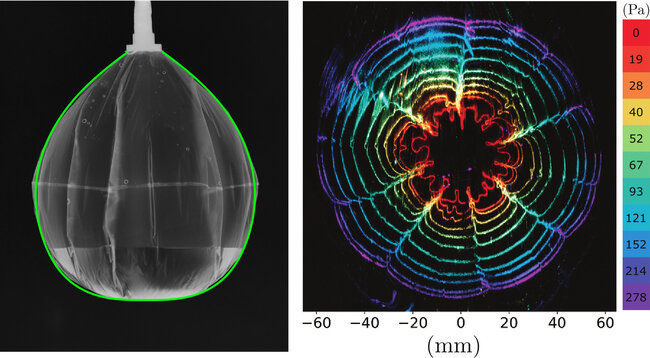 Although thin films are typically manufactured in planar sheets or rolls, they are often forced into three-dimensional (3D) shapes, producing a plethora of structures across multiple length scales. To understand this complex response, previous studies have either focused on the overall gross shape or the small-scale buckling that decorates it. A geometric model, which considers the sheet as inextensible yet free to compress, has been shown to capture the gross shape of the sheet. However, the precise meaning of such predictions, and how the gross shape constrains the fine features, remains unclear. Here, we study a thin-membraned balloon as a prototypical system that involves a doubly curved gross shape with large amplitude undulations. By probing its side profiles and horizontal cross-sections, we discover that the mean behavior of the film is the physical observable that is predicted by the geometric model, even when the buckled structures atop it are large. We then propose a minimal model for the horizontal cross-sections of the balloon, as independent elastic filaments subjected to an effective pinning potential around the mean shape. Despite the simplicity of our model, it reproduces a broad range of phenomena seen in the experiments, from how the morphology changes with pressure to the detailed shape of the wrinkles and folds. Our results establish a route to combine global and local features consistently over an enclosed surface, which could aid the design of inflatable structures, or provide insight into biological patterns.
Although thin films are typically manufactured in planar sheets or rolls, they are often forced into three-dimensional (3D) shapes, producing a plethora of structures across multiple length scales. To understand this complex response, previous studies have either focused on the overall gross shape or the small-scale buckling that decorates it. A geometric model, which considers the sheet as inextensible yet free to compress, has been shown to capture the gross shape of the sheet. However, the precise meaning of such predictions, and how the gross shape constrains the fine features, remains unclear. Here, we study a thin-membraned balloon as a prototypical system that involves a doubly curved gross shape with large amplitude undulations. By probing its side profiles and horizontal cross-sections, we discover that the mean behavior of the film is the physical observable that is predicted by the geometric model, even when the buckled structures atop it are large. We then propose a minimal model for the horizontal cross-sections of the balloon, as independent elastic filaments subjected to an effective pinning potential around the mean shape. Despite the simplicity of our model, it reproduces a broad range of phenomena seen in the experiments, from how the morphology changes with pressure to the detailed shape of the wrinkles and folds. Our results establish a route to combine global and local features consistently over an enclosed surface, which could aid the design of inflatable structures, or provide insight into biological patterns.

